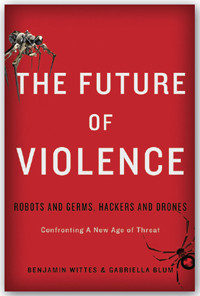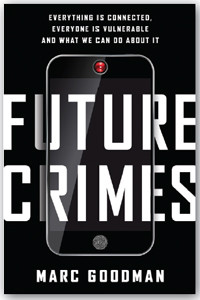
The Future of Violence: Robots and Germs, Hackers and Drones—Confronting a New Age of Threat
Benjamin Wittes & Gabriella Blum
324 pages, Basic Books
My fellow futurists and I often lament that being a futurist is a stressful occupation. Two new books—The Future of Violence, by Benjamin Wittes and Gabriella Blum, and Future Crimes, by Marc Goodman—make it easy to see why. Both books describe a growing list of technologies that, even as they deliver a dizzying array of benefits, make us more vulnerable to threats than ever before.
“Nothing vast enters the life of mortals without a curse,” the Greek playwright Sophocles wrote. That pronouncement came to mind as I read about how easy it would be for students in a lab to use gene-splicing technologies—the same technologies that scientists use to treat crippling diseases—to recreate the smallpox virus and quickly spread it in highly populated urban areas. Reading about robots was equally stressful. Today we use robots in operating rooms to support surgical procedures and on battlefields to scan the terrain and to deliver supplies. But what happens when these automated tools fall into the hands of criminals who decide to reprogram them for nefarious purposes? Then there is the technology that enables and underlies all of the other new technologies: the vast and ever-growing digital network that connects devices in our homes and offices and, increasingly, on our bodies. Such devices continuously collect and transmit data and then store those data on remote servers that are highly vulnerable to digital stalkers, data aggregators, and members of cyber-crime syndicates. To be sure, these devices empower us. But the more that everything we touch, carry, and wear becomes part of a network, the less secure we become.
If you are thinking, “Well, I can just get rid of my iPhone, close my Facebook account, and stop banking online,” then I have bad news for you. Even if you never touch a computer or a mobile phone again, you are still vulnerable. Unless you plan to flee into the woods and never drive a car or take a bus or fl y in an airplane, you cannot escape the global information network. Our basic infrastructure—including our utilities, our transportation systems, and our energy grid—is now a part of that network and can’t function without it. Herein lies a paradox of contemporary life that both of these books urgently bring to our attention: Democratized access to information and universal connectivity go hand in hand with democratized insecurity and universal vulnerability.
Democratized access to information and universal connectivity go hand in hand with democratized insecurity and universal vulnerability.
Wittes, a senior fellow at the Brookings Institution, and Blum, a professor at Harvard Law School, point out that the technologies we use are not just technologies; they are platforms. By itself, a platform does not produce anything, but it creates a common set of procedures and specifi cations for human activity. Each new platform enables an increase in networking by opening new ways to connect people, places, and organizations. Like all good futurists, Wittes and Blum put our current predicament into historical perspective. They cite an earlier platform innovation—the 80,000-kilometer (50,000-mile) system of roads built by the Roman Empire across Europe, the Near East, and North Africa. These roads, Wittes and Blum note, “allowed Rome to move troops around the empire quickly and thus to project power into the far reaches of her domain. They allowed commerce and human mobility. They operated, in short, as a giant platform for Rome’s expansion and the projection of her culture over a huge geographic area, a platform for growth, communication, and human interactivity. They were the closest thing to the Internet the ancient world had.” Along with increasing trade and cultural exchange, however, the roads increased opportunities for banditry. In fact, banditry spiked to such a level after the assassination of Julius Caesar that parts of the network became almost impassable. In response, Rome mounted a brutal security campaign that consisted of executions, searches, and the stationing of sentries along the roads. And it worked. Within a year, the empire was able to restore order.
That analogy illustrates the critical dilemmas that we confront in the new world of technological platforms. Even as these platforms open up opportunities for growth and creativity, they also serve as venues where new types of banditry can take place. As a result, we are now grappling with the need to develop systems of regulation, policing, and surveillance in order to minimize cyber-banditry. How do we balance the use of these measures with the goal of protecting liberty and personal privacy? Indeed, what does personal privacy mean in a world where we freely share personal information and leave an often deliberately public digital trail across various platforms?
To help us navigate such challenges, Wittes and Blum suggest that we view certain core values of democracy—liberty, security, and privacy—as existing in a state of “hostile symbiosis.” They borrow that concept from earlier writers, including the evolutionary biologist Julian Huxley and the science fiction writer H. G. Wells. Quoting Wells, they note that the tissues of the human body are “all of the same parentage, all thriving best when working for the common good, and yet each ready to take advantage of the rest, should opportunity offer.” For Wittes and Blum, the same dynamic applies to the relationship between liberty, privacy, and security. We live in an age when “any entity can theoretically attack or defend you,” they write. “It is a relationship of profound mutual dependence yet, simultaneously, mutual danger and hostility.” To maintain a state of mutual benefit, therefore, governance approaches need to focus on regulatory efforts that allow for “elaborate adjustment” (to use Wells’s term). Wittes and Blum do not give concrete prescriptions in that regard, but they provide a much-needed intellectual framework for policymaking in an environment defined by technology-based platforms.

Future Crimes: Everything Is Connected, Everyone Is Vulnerable, and What We Can Do About It Marc Goodman - 392 pages, Doubleday
Future Crimes covers a lot of the same territory as The Future of Violence, albeit in much greater detail. It also highlights another dimension to the relationship between security, privacy, and liberty. Goodman, a security scholar and consultant, vividly shows that much of our loss of privacy results not from high-minded concerns about security, but from the commercial imperative to sell us diapers, toothpaste, and other bounties of the market economy. In online communities, for example, we willingly share our personal health information in order to gain knowledge and to improve health outcomes. Yet there are armies of unregulated data aggregators that routinely glean that information and then sell it to pharmaceutical companies and other organizations so that those entities can market something to us. (Former Vice President Al Gore and others have referred to this process as the “stalker economy.”)
Many of the platforms that we use every day, from Facebook to OKCupid to WebMD, are ultimately little more than a means of extracting our personal data. In the advertising-based model that powers most of these platforms, we are the product. And that model exposes our data not just to legitimate companies but also to the forces of Crime Inc., as Goodman labels it—an increasingly well-organized and well-financed global network that steals large amounts of personal data for commercial and political purposes.
Goodman offers several well-conceived proposals for combatting Crime Inc., ranging from efforts to crowdsource security work to the use of competitions and prizes. He also issues a call to establish a Manhattan Project to fight cyber-crime—a bold project that would “draw together some of the greatest minds of our time, from government, academia, the private sector, and civil society.”
His call has urgency. We are quickly approaching the point at which our new platforms might become unusable, just as the roads of the Roman Empire became impassable until imperial authorities engaged in a huge effort to improve security. Both books, therefore, are essential reading not only for policymakers but for anyone who seeks to understand how we can maintain a healthy symbiosis in the new world of technology platforms.

